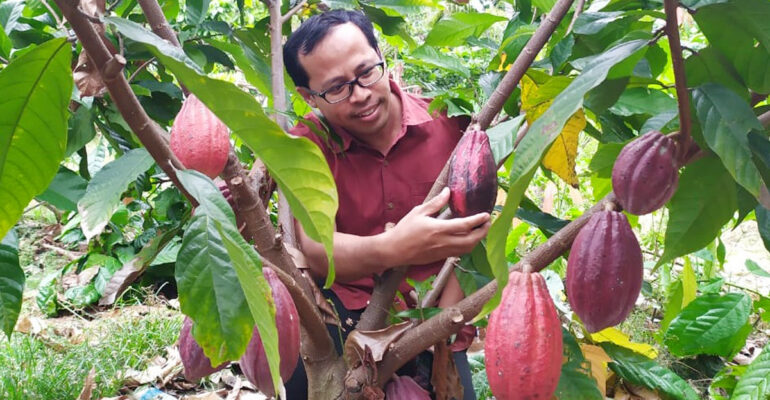The IPB University PSP3 Team Researches the Decrease of Cocoa Production in North Kolaka

Cocoa plants are almost spread throughout the area in North Kolaka Regency, Southeast Sulawesi and have even become ‘culture’ plants in the community. This can certainly be an important factor to encourage North Kolaka to be developed as the City of Cocoa.
“The prerequisite is to make North Kolaka Regency as a Cacao City. The only problem is how good faith from various elements such as farmers, village government, local government, central government, universities and the private sector are brought together and organized in that direction,” said Dr. Sofyan Sjaf, Head of Center for Agricultural and Rural Development Studies (PSP3) , Institute of Research and Community Service (LPPM) of IPB University when opening the Cocoa Plan Study Analysis and Analysis Seminar at Aulia Wisma Lasusua, North Kolaka (7/19).
Before holding this seminar, PSP3 had fielded a research team to carry out field observations of the Indepth Interview, questionnaire distribution, and Focus Group Discussion (FGD) in North Kolaka Regency. The team consisted of Dr. Sofyan Sjaf, Dr. Baba Barus, Dr. Suprehatin, Rajib Gandi, Muklis Pribadi and Tisha Alya Arifiani. Research was conducted in two sub-districts, namely Ngapa District and Pakue Subdistrict, because these two sub-districts had higher cocoa production than other sub-districts in North Kolaka Regency.
The seminar which was held to present the results of this research was attended by the North Kolaka Regency Government, the Quality Control Team for Activities from the University of November 19 Lasusua, as well as representatives from the Extension and Mantri Garden (Manbun) from 15 sub-districts in North Kolaka Regency.
1998 was the heyday of cocoa, where the price of cocoa that year reached 20,000 rupiah per kilogram. This has an impact on increasing people’s welfare quickly. Even at that time North Kolaka, which was a par of Kolaka Regency, was referred to as a Dollar-Producing Region.
“Our findings in the field show a decline in cocoa productivity. Since the emergence of cocoa diseases such as Cacao Fruit Borer (PBK) around 2005, cocoa productivity began to decline. Cocoa decreased by 75 percent from the 1990s. Now the production costs are greater than the production. According to residents, 1998 can get 2-3 tons per harvest, but now only two quintals are harvested,” said Chairman of the Research Team, Dr. Baba Barus.
According to him, cocoa productivity needs to be improved because if it continues to decline, efforts to develop cocoa business will be difficult. In addition to productivity problems, there are also two marketing channels for cocoa production, namely the Traditional Supply Chain and the Global Cocoa Value Chain.
In the traditional supply chain, products sold at the level of farmers and collectors are semi-dried cocoa beans and non-fermented dry cocoa beans, where the quality and standards of their products vary. The marketing chain is also relatively longer, where the marketing flow of cocoa beans is from farmers to village or sub-district level traders to large exporters and the latest processing industries of exporters.
In the global cocoa value chain, the marketing chain is relatively shorter and coordinated. The marketing flow is only from farmers to collectors, then to the company. Products sold in the global value chain are wet cocoa beans that specifically meet global market demand.
In the Global Value Chain, Cocoa has been implemented by Public Private Partnership where one of its programs is the Sustainable Cocoa Production Program (SCPP). This program is a multi-stakeholder collaboration program that focuses on sustainable business and providing benefits to all stakeholders. At the level of the cocoa farmer, this program focuses on being able to increase cocoa productivity and farmers’ skills. While at the company level, this program wants to focus on being able to meet market demand (supply of stable and high-quality cocoa beans).
“The findings and results of this preliminary seminar discussion are expected to support the Cocoa Revitalization program which is currently being carried out by the North Kolaka Regency Government in order to increase cocoa productivity in the region,” he said. (RYS)



